
TNU Journal of Science and Technology
230(02): 128 - 138
http://jst.tnu.edu.vn 128 Email: jst@tnu.edu.vn
ARSENIC CONTAMINATION IN SOIL: CAUSES, EFFECTS, AND
EFFECTIVE REMEDIATION SOLUTIONS - A MINIREVIEW
Nguyen Thi Minh Phuong *
Duy Tan University
ARTICLE INFO
ABSTRACT
Received:
02/01/2025
The study examines the critical issue of arsenic contamination in soil,
focusing on its sources, impacts, and remediation strategies. Aiming to
understand the origins and consequences of arsenic pollution, the research
evaluates effective mitigation methods. By conducting a comprehensive
review of existing literature and theoretical frameworks, the study
investigates contamination sources, including industrial and agricultural
activities, and assesses remediation techniques such as adsorption,
bioremediation, and chemical stabilization. The findings reveal that arsenic
concentrations frequently exceed safety thresholds, with groundwater levels
reaching up to 500 µg/L and soil levels up to 50 mg/kg. These elevated
concentrations lead to reduced soil fertility, decreased crop yields, and
severe health risks, including cancer and organ damage. To address these
challenges, the study highlights effective remediation strategies, including
the use of adsorbent materials (e.g., activated carbon), biological approaches
such as phytoremediation, and the enforcement of stringent controls over
arsenic emissions. The findings emphasize the urgent need for integrated
approaches that combine advanced technologies, biological interventions,
and regulatory measures to effectively mitigate arsenic contamination and
safeguard environmental and public health.
Revised:
17/02/2025
Published:
19/02/2025
KEYWORDS
Arsenic
Soil contamination
Phytoremediation
Bioremediation
Arsenic remediation
Ô NHIỄM ASEN TRONG ĐẤT: NGUYÊN NHÂN, ẢNH HƯỞNG VÀ CÁC GIẢI
PHÁP XỬ LÝ HIỆU QUẢ: MỘT BÀI ĐÁNH GIÁ NGẮN
Nguyễn Thị Minh Phương
Đại học Duy Tân
THÔNG TIN BÀI BÁO
TÓM TẮT
Ngày nhận bài:
02/01/2025
Nghiên cứu này xem xét vấn đề quan trọng về ô nhiễm asen trong đất, tập
trung vào các nguồn gốc, tác động và chiến lược xử lý. Nhằm hiểu rõ nguồn
gốc và hậu quả của ô nhiễm asen, nghiên cứu này đánh giá các phương pháp
giảm thiểu hiệu quả. Thông qua việc tổng hợp tài liệu hiện có và các khung
lý thuyết, nghiên cứu tìm hiểu các nguồn ô nhiễm như hoạt động công nghiệp
và nông nghiệp, đồng thời đánh giá các kỹ thuật xử lý như hấp phụ, xử lý
sinh học và ổn định hóa học. Kết quả cho thấy nồng độ asen thường vượt
ngưỡng an toàn, với mức trong nước ngầm lên đến 500 µg/L và trong đất lên
đến 50 mg/kg. Những nồng độ cao này gây ra sự suy giảm độ phì nhiêu của
đất, giảm năng suất cây trồng và các nguy cơ nghiêm trọng về sức khỏe, bao
gồm ung thư và tổn thương cơ quan nội tạng. Để giải quyết những thách thức
này, nghiên cứu đề xuất các chiến lược xử lý hiệu quả như sử dụng vật liệu
hấp phụ (ví dụ, than hoạt tính), phương pháp sinh học như phytoremediation,
và thực thi các biện pháp kiểm soát nghiêm ngặt đối với phát thải asen. Kết
quả nhấn mạnh sự cần thiết của các cách tiếp cận tích hợp kết hợp công nghệ
tiên tiến, can thiệp sinh học và các biện pháp quản lý nhằm giảm thiểu ô
nhiễm asen và bảo vệ môi trường cũng như sức khỏe cộng đồng.
Ngày hoàn thiện:
17/02/2025
Ngày đăng:
19/02/2025
TỪ KHÓA
Asen
Ô nhiễm đất
Phytoremediation
Bioremediation
Xử lý asen
DOI: https://doi.org/10.34238/tnu-jst.11807
Email: nguyentminhphuong@dtu.edu.vn

TNU Journal of Science and Technology
230(02): 128 - 138
http://jst.tnu.edu.vn 129 Email: jst@tnu.edu.vn
1. Giới thiệu
Ô nhiễm asen (As) trong đất là một vấn đề môi trường nghiêm trọng, có tác động sâu rộng đến
chất lượng đất, sức khỏe con người và động thực vật. Với khả năng tích tụ trong môi trường, As
không chỉ làm giảm độ phì nhiêu của đất mà còn gây ra những rủi ro lớn cho hệ sinh thái, bao
gồm sự suy giảm đa dạng sinh học và nguy cơ tích tụ As trong chuỗi thực phẩm [1], [2]. Ô nhiễm
As không chỉ ảnh hưởng đến cây trồng mà còn có thể xâm nhập vào chuỗi thực phẩm, gây ra
những rủi ro sức khỏe nghiêm trọng cho con người. Các nghiên cứu đã chỉ ra rằng việc tiêu thụ
thực phẩm bị ô nhiễm As có thể dẫn đến các vấn đề sức khỏe như ung thư và các rối loạn khác
[3]. Hơn nữa, ô nhiễm As cũng ảnh hưởng đến động vật hoang dã, làm giảm đa dạng sinh học và
gây ra sự suy giảm quần thể động thực vật trong các khu vực bị ô nhiễm [4]. Một nghiên cứu cho
thấy rằng nồng độ As cao trong đất có thể dẫn đến sự tích tụ As trong thực phẩm, đặc biệt là
trong gạo, làm giảm giá trị dinh dưỡng của sản phẩm [1], [5].
Ngoài ra, ô nhiễm As trong đất còn có thể gây ra những vấn đề pháp lý và xã hội nghiêm
trọng. Các vụ kiện liên quan đến ô nhiễm môi trường thường xoay quanh các vấn đề như trách
nhiệm của các công ty trong việc bảo vệ môi trường và sức khỏe cộng đồng [6]. Điều này cho
thấy rằng việc quản lý ô nhiễm As không chỉ là một vấn đề kỹ thuật mà còn là một thách thức lớn
về chính sách và pháp lý. Đặc biệt, trong các khu vực như Bangladesh, nơi mà nước ngầm bị ô
nhiễm As, việc sử dụng nước này cho tưới tiêu có thể dẫn đến ô nhiễm đất và ảnh hưởng đến sức
khỏe cộng đồng [3], [7].
Mức độ ô nhiễm As trong đất đang trở thành một vấn đề môi trường nghiêm trọng ở nhiều
khu vực trên thế giới, đặc biệt là ở những nơi có hoạt động nông nghiệp và công nghiệp. Theo
các nghiên cứu, nồng độ As trong đất có thể vượt quá mức giới hạn an toàn, gây ảnh hưởng lớn
đến chất lượng đất, cây trồng và sức khỏe con người. Một nghiên cứu tại Bangladesh cho thấy
nồng độ As trong đất nông nghiệp có thể dao động từ 10 đến 500 mg/kg, trong khi giới hạn an
toàn theo Tổ chức Y tế Thế giới (WHO) là dưới 10 mg/kg [8]. Tại Ấn Độ, các khu vực chịu ô
nhiễm nặng từ thuốc trừ sâu chứa As đã ghi nhận nồng độ As trong đất lên tới 100 mg/kg, khiến
đất trở nên kém màu mỡ và ảnh hưởng trực tiếp đến năng suất cây trồng [9].
Tại Việt Nam, các khu vực đồng bằng sông Cửu Long cũng ghi nhận mức độ ô nhiễm As
trong đất nông nghiệp cao, chủ yếu do sử dụng thuốc trừ sâu và ô nhiễm từ các khu công nghiệp,
làm tăng nguy cơ lây nhiễm As vào nguồn nước và thực phẩm [10], [11]. Các nghiên cứu cho
thấy As trong đất có thể gây độc cho cây trồng, làm giảm năng suất, đặc biệt là các cây ngũ cốc
như lúa, nơi mà mức độ As cao có thể làm giảm đến 30-50% năng suất so với các khu vực không
ô nhiễm [12]. Việc này không chỉ ảnh hưởng đến sản lượng nông nghiệp mà còn có thể dẫn đến
các vấn đề sức khỏe nghiêm trọng cho người tiêu dùng, đặc biệt là ở những khu vực có tỷ lệ tiêu
thụ gạo cao như Bangladesh và Ấn Độ [13].
Để giải quyết vấn đề ô nhiễm As trong đất, cần có các biện pháp quản lý và giám sát hiệu quả.
Các nghiên cứu đã chỉ ra rằng việc áp dụng các công nghệ xử lý và phục hồi đất có thể giúp giảm
thiểu ô nhiễm As [14], [15]. Hơn nữa, việc nâng cao nhận thức cộng đồng về tác động của ô
nhiễm As và khuyến khích các hành động bảo vệ môi trường cũng là rất cần thiết [16]. Việc sử
dụng các biện pháp sinh học như than sinh học cũng đã được đề xuất như một giải pháp tiềm
năng để giảm thiểu ô nhiễm As trong đất [14], [15].
Mục tiêu của bài báo này là cung cấp cái nhìn toàn diện về ô nhiễm As trong đất, bao gồm các
nguồn gốc gây ô nhiễm, tác động của As đối với môi trường và sức khỏe con người, cũng như
các phương pháp giám sát và xử lý hiệu quả. Bài báo sẽ phân tích các nguyên nhân chủ yếu dẫn
đến ô nhiễm As trong đất, từ hoạt động tự nhiên đến sự tác động của con người qua nông nghiệp
và công nghiệp. Đồng thời, bài báo cũng sẽ trình bày những ảnh hưởng tiêu cực của As đối với
chất lượng đất, năng suất cây trồng và sức khỏe cộng đồng. Cuối cùng, bài báo sẽ xem xét các
giải pháp xử lý và giảm thiểu ô nhiễm As, bao gồm các phương pháp sinh học, hóa học và kỹ
thuật, nhằm bảo vệ môi trường và đảm bảo sự phát triển bền vững.

TNU Journal of Science and Technology
230(02): 128 - 138
http://jst.tnu.edu.vn 130 Email: jst@tnu.edu.vn
2. Phương pháp nghiên cứu
Phương pháp nghiên cứu chính trong bài báo này là tổng quan và đánh giá toàn diện về ô
nhiễm As trong đất, với mục tiêu làm rõ các nguồn gốc gây ô nhiễm, ảnh hưởng của As đối với
môi trường và sức khỏe con người, cũng như các phương pháp xử lý hiệu quả. Cụ thể, bài báo sử
dụng phương pháp tổng hợp tài liệu kết hợp với phân tích các nguyên lý lý thuyết và thực tiễn
liên quan đến ô nhiễm As trong đất. Bài báo tập trung vào các yếu tố quan trọng như nguồn gốc
tự nhiên và nhân tạo của As, sự tác động của As đến chất lượng đất, năng suất cây trồng và sức
khỏe cộng đồng. Ngoài ra, phương pháp nghiên cứu cũng bao gồm việc phân tích các biện pháp
xử lý và giám sát ô nhiễm As, từ các giải pháp sinh học (phytoremediation) đến các phương pháp
hóa học và vật lý, nhằm giảm thiểu mức độ ô nhiễm và cải thiện chất lượng đất. Bài báo cũng
xem xét việc áp dụng các nguyên lý bảo vệ môi trường, như nguyên lý phòng ngừa ô nhiễm, để
đảm bảo an toàn cho cộng đồng và môi trường trong dài hạn.
3. Kết quả nghiên cứu và thảo luận
3.1. Nguồn gốc ô nhiễm As trong đất
3.1.1. Nguồn tự nhiên
* Phong hóa đá chứa arsenopyrit và hoạt động núi lửa:
Ô nhiễm As trong đất không chỉ do hoạt động của con người mà còn có thể phát sinh từ các
nguồn tự nhiên. Một trong những nguồn chính là quá trình phong hóa đá, trong đó As được giải
phóng từ các khoáng vật chứa As trong đá mẹ, sau đó di chuyển vào đất. Các nghiên cứu cho
thấy, trong một số khu vực như các vùng núi hoặc cao nguyên, nồng độ As trong đất có thể lên
tới 20-50 mg/kg do sự phong hóa tự nhiên của các đá chứa arsenopyrit (FeAsS) hoặc các khoáng
vật chứa As khác [1]. Ví dụ, khu vực miền Tây Hoa Kỳ, nơi các vùng đất đá cổ có nồng độ As tự
nhiên trong đất dao động từ 10 đến 100 mg/kg, đã được ghi nhận là một trong những khu vực có
nồng độ As cao do sự phong hóa tự nhiên [1].
Hoạt động núi lửa cũng đóng vai trò quan trọng trong việc phát tán As vào môi trường. Trong
những vụ phun trào núi lửa, các khí và tro núi lửa chứa As được thải ra môi trường, sau đó lắng
đọng trên bề mặt đất. Ở các khu vực gần núi lửa, nồng độ As trong đất có thể gia tăng đột ngột.
Ví dụ, tại một số khu vực ở Indonesia và Chile, nồng độ As trong đất đã được đo tới mức 200
mg/kg sau các vụ phun trào núi lửa [17]. Kết quả nghiên cứu tại các khu vực đó cho thấy rằng các
quá trình địa chất tự nhiên, bao gồm cả hoạt động núi lửa, có thể làm tăng nồng độ As trong đất
và nước ngầm, gây ra những rủi ro sức khỏe cho cộng đồng sống gần đó.
* Sự rửa trôi As vào nước ngầm:
Sự vận chuyển của As từ đất vào nước ngầm cũng là một yếu tố quan trọng trong ô nhiễm As.
Khi As từ đất bị hòa tan trong nước mưa hoặc nước ngầm, nó có thể di chuyển và tích tụ trong
các nguồn nước, đặc biệt là ở những khu vực có điều kiện thủy văn đặc biệt. Tại Bangladesh và
Ấn Độ, nồng độ As trong nước ngầm đã vượt quá 500 µg/L, vượt xa mức giới hạn an toàn là 10
µg/L theo tiêu chuẩn của WHO, do sự rửa trôi As từ đất vào các tầng nước ngầm [18]. Điều này
khiến hàng triệu người dân ở các khu vực này phải đối mặt với nguy cơ mắc bệnh do As, đặc biệt
là khi nước ngầm được sử dụng cho sinh hoạt và tưới tiêu [19].
Do đó, việc giám sát và xử lý ô nhiễm As trong đất là rất cần thiết để bảo vệ môi trường và
sức khỏe cộng đồng. Các biện pháp như cải thiện quản lý đất đai, sử dụng các phương pháp canh
tác bền vững và áp dụng công nghệ sinh học để giảm thiểu ô nhiễm As trong đất đã được đề xuất.
Hơn nữa, việc nâng cao nhận thức cộng đồng về tác động của ô nhiễm As cũng là một yếu tố
quan trọng trong việc giảm thiểu rủi ro sức khỏe và bảo vệ môi trường.

TNU Journal of Science and Technology
230(02): 128 - 138
http://jst.tnu.edu.vn 131 Email: jst@tnu.edu.vn
3.1.2. Nguồn nhân tạo
* Sử dụng thuốc trừ sâu và phân bón chứa As trong nông nghiệp: Ô nhiễm As trong đất do hoạt
động của con người chủ yếu phát sinh từ ba nguồn chính: sử dụng thuốc trừ sâu chứa As trong nông
nghiệp, xả thải công nghiệp, và ô nhiễm từ nước thải sinh hoạt cũng như khu công nghiệp. Trong
nhiều thập kỷ qua, các loại thuốc trừ sâu và phân bón chứa As đã được sử dụng rộng rãi trong nông
nghiệp để kiểm soát sâu bệnh và tăng cường năng suất cây trồng. Các sản phẩm như cacbua đồng
(CuAs) và các loại thuốc trừ sâu chứa hợp chất As có thể dễ dàng xâm nhập vào đất và tích tụ theo
thời gian. Ví dụ, ở các khu vực nông thôn tại Trung Quốc, Ấn Độ và Việt Nam, việc sử dụng thuốc
trừ sâu chứa As đã dẫn đến nồng độ As trong đất nông nghiệp tăng lên đáng kể, với mức độ có thể
vượt quá 50 mg/kg [20]. Một nghiên cứu tại Ấn Độ cho thấy nồng độ As trong đất nông nghiệp tại
các vùng trồng lúa có thể lên tới 100 mg/kg, cao hơn nhiều so với mức giới hạn an toàn [21]. Điều
này không chỉ ảnh hưởng đến chất lượng đất mà còn dẫn đến việc cây trồng hấp thụ As, từ đó ảnh
hưởng đến sức khỏe của con người khi tiêu thụ các nông sản.
* Xả thải công nghiệp từ khai thác, chế biến kim loại, và sản xuất hóa chất: Xả thải công nghiệp
là một nguồn ô nhiễm As nghiêm trọng, đặc biệt là trong các ngành khai thác, chế biến kim loại và
sản xuất hóa chất. Trong quá trình khai thác và chế biến quặng, As thường tồn tại dưới dạng các
hợp chất kim loại, và khi không được xử lý đúng cách, chúng có thể xả ra môi trường, gây ô nhiễm
đất và nguồn nước. Chẳng hạn, ở các khu vực khai thác vàng và đồng tại Peru và Indonesia, nồng
độ As trong đất và nước đã vượt quá mức cho phép hàng trăm lần, với các khu vực có mức độ ô
nhiễm lên tới 500 mg/kg [22]. Trong các ngành công nghiệp chế biến kim loại, As cũng có thể
được thải ra trong quá trình nấu chảy quặng và sản xuất các hợp chất kim loại. Các khu vực gần các
nhà máy chế biến kim loại như ở Trung Quốc và Mexico đã ghi nhận nồng độ As trong đất có thể
lên tới 200 mg/kg, gây ảnh hưởng đến hệ sinh thái và sức khỏe cộng đồng [23].
* Ô nhiễm từ nước thải sinh hoạt và khu công nghiệp: Nước thải sinh hoạt và nước thải từ các
khu công nghiệp cũng là một nguồn ô nhiễm As đáng kể. Trong quá trình xử lý nước thải sinh
hoạt hoặc nước thải từ các khu công nghiệp, As có thể tồn tại dưới dạng hòa tan hoặc kết tủa và
xâm nhập vào đất và nguồn nước. Nồng độ As trong nước thải sinh hoạt có thể dao động từ 0,1
đến 10 µg/L, nhưng khi nước thải này không được xử lý hoặc được thải ra môi trường một cách
không kiểm soát, nó có thể dẫn đến ô nhiễm As nghiêm trọng [24]. Tại một số khu công nghiệp ở
Ấn Độ và Bangladesh, nước thải chứa As từ các nhà máy dệt nhuộm, hóa chất và xử lý kim loại
đã làm tăng nồng độ As trong đất và nước ngầm lên mức rất cao. Một nghiên cứu tại Bangladesh
chỉ ra rằng nồng độ As trong nước ngầm tại các khu công nghiệp có thể lên đến 1000 µg/L, vượt
xa mức an toàn cho phép của WHO (10 µg/L) [25].
c đ ng của ô nhiễm As
3.2.1. Tác động đến đất và cây trồng
* Tác động đến đất: Ô nhiễm As trong đất có ảnh hưởng sâu rộng đến nhiều yếu tố trong hệ sinh
thái đất, từ cấu trúc đất đến sinh vật và cây trồng. Đầu tiên, As có thể tác động tiêu cực đến cấu trúc
đất, làm giảm độ phì nhiêu, khả năng trao đổi chất và tính chất vật lý của đất (Bảng 1). Nồng độ As
cao trong đất có thể làm giảm khả năng giữ nước của đất và gây ra sự mất cân bằng trong các khoáng
chất thiết yếu, ảnh hưởng đến sự phát triển của cây trồng. Các nghiên cứu tại các khu vực ô nhiễm As
ở Bangladesh cho thấy đất có chứa hơn 100 mg/kg As có độ pH giảm và khả năng hấp thụ các chất
dinh dưỡng bị suy giảm, dẫn đến đất trở nên khô cằn và kém màu mỡ [26], [27].
Bên cạnh đó, sinh vật trong đất, đặc biệt là vi sinh vật và giun đất, cũng bị ảnh hưởng nghiêm
trọng bởi As. Các vi sinh vật có vai trò quan trọng trong việc phân hủy chất hữu cơ và duy trì độ phì
nhiêu của đất. Khi nồng độ As trong đất vượt quá 50 mg/kg, nhiều loại vi sinh vật trong đất không
thể sinh trưởng và phát triển, gây rối loạn trong chu trình dinh dưỡng [28]. Giun đất, vốn là một
phần quan trọng trong quá trình cải thiện cấu trúc đất, cũng bị độc bởi As, dẫn đến tỷ lệ sống sót

TNU Journal of Science and Technology
230(02): 128 - 138
http://jst.tnu.edu.vn 132 Email: jst@tnu.edu.vn
giảm và ảnh hưởng đến chuỗi thức ăn trong đất. Nghiên cứu tại các khu vực ô nhiễm As ở Ấn Độ
cho thấy sự suy giảm đáng kể về số lượng giun đất và các sinh vật hữu ích khác trong đất [29].
* Tác động đến cây trồng: cây trồng cũng chịu ảnh hưởng nghiêm trọng từ ô nhiễm As trong
đất. Khi cây hấp thu As từ đất, không chỉ năng suất cây trồng bị giảm mà chất lượng nông sản
cũng bị ảnh hưởng. As tích tụ trong cây trồng, đặc biệt là trong lúa, có thể khiến nồng độ As trong
thực phẩm vượt quá mức giới hạn an toàn cho con người. Các nghiên cứu cho thấy, tại các khu
vực ô nhiễm As ở Việt Nam, nồng độ As trong lúa có thể đạt tới 0,5 mg/kg, vượt quá mức an
toàn được WHO khuyến cáo là 0,1 mg/kg [30]. Điều này không chỉ làm giảm năng suất cây trồng
mà còn gây nguy cơ sức khỏe cho người tiêu thụ, vì As là chất gây ung thư và có thể gây ra các
bệnh về tim mạch, thần kinh và hệ tiêu hóa khi tích tụ lâu dài trong cơ thể [31].
Bảng Tác động của As đến đất và hệ sinh thái
Tác động
Chi tiết
Nghiên cứu minh họa
Tác động đến đất
As làm giảm độ phì nhiêu, khả năng giữ
nước và cân bằng khoáng chất trong đất. Đất
chứa >100 mg/kg As có độ pH giảm và suy
giảm khả năng hấp thụ dinh dưỡng.
Bangladesh: Đất chứa >100 mg/kg
As bị suy giảm độ màu mỡ và khả
năng hấp thụ dinh dưỡng [26], [27].
Tác động đến sinh
vật trong đất
Nồng độ As > 50 mg/kg làm vi sinh vật và
giun đất bị suy giảm, ảnh hưởng đến chu
trình dinh dưỡng và chuỗi thức ăn trong đất.
Ấn Độ: Giảm đáng kể số lượng
giun đất và sinh vật hữu ích trong
đất tại vùng ô nhiễm As [28], [29].
Tác động đến cây
trồng
As tích tụ trong cây trồng (đặc biệt là lúa),
giảm năng suất và chất lượng nông sản. Lúa
từ vùng ô nhiễm As ở Việt Nam có thể chứa
tới 0,5 mg/kg As, vượt mức an toàn của
WHO (0,1 mg/kg).
Việt Nam: Nồng độ As trong lúa tại
vùng ô nhiễm đạt 0,5 mg/kg, vượt
mức an toàn [30], [31].
Bảng Tác động của As đến sức khỏe con người
Tác động
Chi tiết
Nghiên cứu minh họa
Gây ung thư
Gây ung thư da, phổi, bàng quang và thận.
Nguy cơ ung thư phổi tăng 2-3 lần khi tiếp
xúc lâu dài với As > 50 µg/L.
Bangladesh: Nước ngầm As > 50
µg/L làm tăng ung thư trong cộng
đồng 30-40% [26], [27].
Tổn thương gan
Chuyển hóa ở gan thành hợp chất độc, gây
tổn thương mô gan, rối loạn chức năng gan,
tăng nguy cơ bệnh gan mạn tính.
Ấn độ: Người sống trong vùng As
cao có nguy cơ bệnh gan nhiễm mỡ,
xơ gan cao hơn 2 lần [28], [29].
Tổn thương thận
Gây suy thận cấp hoặc mạn tính, nồng độ As
trong máu > 10 µg/L dẫn đến suy giảm chức
năng thận.
Người tiếp xúc As kéo dài có triệu
chứng suy thận nghiêm trọng.
Vấn đề thần kinh
Tác động đến hệ thần kinh trung ương và
ngoại vi, gây rối loạn trí nhớ, mất tập trung,
giảm IQ ở trẻ em khi tiếp xúc As > 50 µg/L.
Bangladesh: Trẻ em ở vùng As cao
có IQ giảm, khả năng nhận thức
kém [26], [27].
3.2.2. Tác động đến sức khỏe con người
3.2.2.1. Cơ chế gây độc
As là một chất độc hại đáng kể, có khả năng tích tụ trong cơ thể người và động vật qua các
con đường tiếp xúc như hít phải bụi chứa As, tiêu thụ nước và thực phẩm bị ô nhiễm, hoặc tiếp
xúc trực tiếp qua da (Bảng 2). As dễ dàng tích tụ trong các cơ quan quan trọng như gan, thận và
hệ thần kinh, và nó gây ra các bệnh lý nghiêm trọng nếu tiếp xúc kéo dài, với các tác động độc
hại được ghi nhận rõ rệt [32].
Một trong những ảnh hưởng nghiêm trọng nhất của As là gây ung thư. As được phân loại là
chất gây ung thư nhóm 1 theo Tổ chức Y tế Thế giới (WHO), có khả năng gây ung thư da, phổi,
bàng quang và thận. Các nghiên cứu dịch tễ học cho thấy những người tiếp xúc lâu dài với nồng

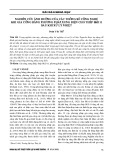
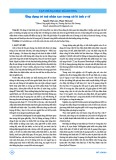


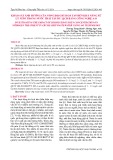

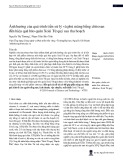
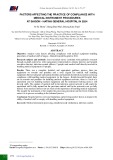

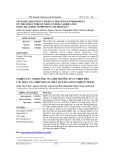











![Bài giảng Kỹ thuật robot [Mới nhất]](https://cdn.tailieu.vn/images/document/thumbnail/2025/20250715/vijiraiya/135x160/366_bai-giang-ky-thuat-robot.jpg)
![Câu hỏi ôn tập Cơ sở xử lý ảnh số [năm] chuẩn nhất](https://cdn.tailieu.vn/images/document/thumbnail/2025/20250710/kimphuong1001/135x160/84701752136985.jpg)

![Câu hỏi ôn tập Robot công nghiệp [năm hiện tại]](https://cdn.tailieu.vn/images/document/thumbnail/2025/20250702/kimphuong555/135x160/7711751422232.jpg)
